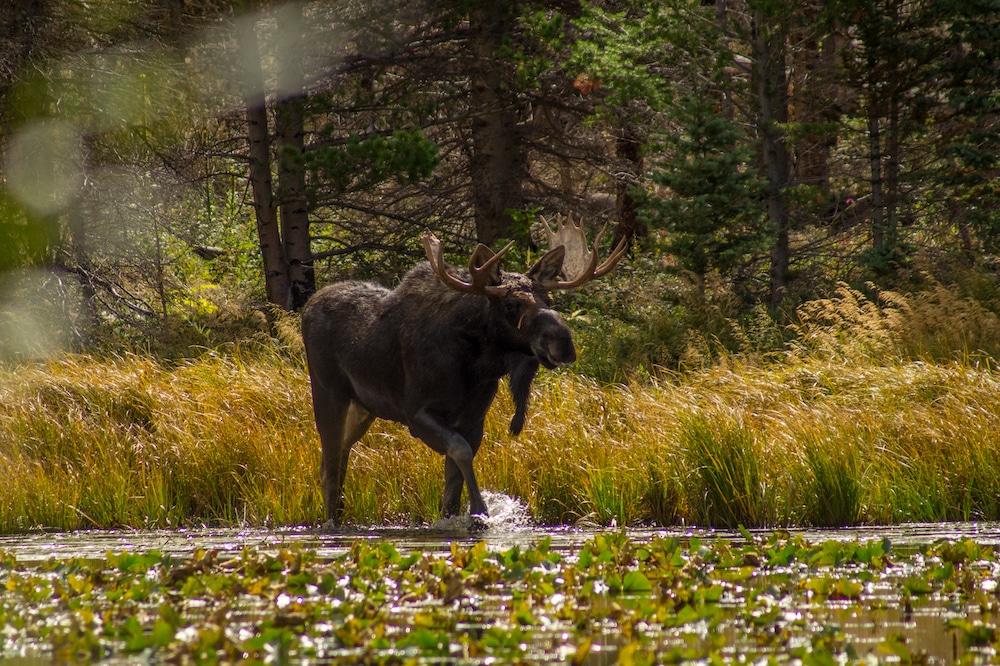Spend enough time in the field and you’ll start to get a feeling when conditions are right for success. Sometimes the weather feels perfect, but other times intuition just tells you, “Today is the day.” This was one of those mornings. After several days of waiting out the Alaska rain in our tent, my husband and I finally woke up to a crisp, clear moosey morning.
Within minutes of my husband letting out the yearning whine of a cow moose, we heard the unmistakable grunt of a bull nearby. The grunting noises moved closer and closer as the bull searched for the cow, its antlers smashing against the brush. The bull appeared 50 yards in front of us. I drew back my bow, released an arrow and watched it hit my target.
My first bull moose with a bow is easily the biggest animal I’ve taken with archery equipment. It took more than a day to butcher the moose, pack it to camp and get it out of the field. But the excitement of the hunt and hundreds of pounds of future meals were well worth the effort.
Moose are one of the most exciting animals to pursue with a bow. If you’ve dreamed of bowhunting them, here’s how to make it happen.

Alaska is the most accessible state for hunting moose. Photo Credit: John Hafner
Moose populations are relatively limited across North America, and therefore hunting opportunities are sparse. I hunted moose in Alaska, which is the most accessible location in North America, where hunters harvest more than 7,000 moose annually, according to the Alaska Department of Fish and Game. Alaska residents have access to over-the-counter moose tags and special permits. Nonresidents can also buy over-the-counter tags and apply for special permits; they’re just more expensive. A guide isn’t required for U.S. residents, but using a guide is required for hunters who reside outside the U.S.
Most Canadian provinces have moose hunting opportunities; unless you’re Canadian, though, you’ll need a guide. Nonresidents must book hunts through outfitters. The price range for a guided moose hunt varies, but you can expect to pay several thousand dollars.
Hunting moose in the Lower 48 requires a lot of luck. Moose hunting is carefully controlled because populations are low. Most hunting opportunities are decided through a special draw system. With limited tags and a lot of applicants, draw odds for a moose are often less than 1%. Many states give preference to residents. Lower 48 states with huntable moose populations include Maine, Idaho, Montana, Colorado, Wyoming, Washington and North Dakota.

Moose are very large animals, so be prepared when it’s time to field dress. Photo Credit: Erik Barber
Whether you’re venturing out with a guide or going DIY, moose hunting involves a special set of considerations. Moose are giants. They’re the largest member of the deer family. A bull Alaska-Yukon moose can weigh up to 1,600 pounds and stand almost 6 feet tall. Its smaller cousin, the Shiras moose, weighs up to 1,200 pounds. That’s a lot of animal.
Moose are hard to hunt — but moose hunters joke that the real work starts when you get one. While many hunters can field-dress a deer on their own, a moose is a different story. You’ll need at least one other person. It’s your job to make sure the meat doesn’t spoil. Make a plan for getting the moose out of the field. Have this plan in place before you go hunting. Unlike a deer, which you can quarter and pack out, on a moose, a quarter can weigh more than the entire deer. Make sure you have help and know your limits. Don’t kill a moose that you can’t get out of the field in time. Once it’s out of the field, if you’ve traveled to the location, have a plan in place for how to get the meat and antlers home.

Bowhunting moose during the rut is similar to bowhunting elk. Photo Credit: John Hafner
Hunt the Rut: Bowhunting moose can be a lot like bowhunting elk. When they’re in the rut, moose are vocal and susceptible to calling. Many bowhunters choose to target moose during the rut for this reason. Moose rut during September. This season allows hunters to get close enough. Hunters mimic cows, hoping to entice a big bull. Many hunters also successfully use raking techniques.
Spend Time Behind the Glass: For as big as they are, moose are shockingly hard to see. Moose thrive in thick brush. Sometimes they’ll stay in the same thicket for days. Before busting through the noisy shrubs in search of your quarry, spend time quietly glassing.
Learn What’s Legal: Wildlife agencies often put antler restrictions in place. In many areas of Alaska, a legal moose must have a minimum antler width of 50 inches or four brow tines on one side. Know the restrictions and how to judge these in the field. If there’s any question at all, don’t take the shot.
Be Careful: Part of the fun of bowhunting is getting close to wildlife. However, in the case of bowhunting moose, close quarters pose a threat. Moose can be aggressive. They injure more people in Alaska annually than bears, according to the ADFG. The rut can trigger this aggression, according to biologists. Keep this in mind during your hunt.
Moose hunting isn’t easy. Whether it’s the luck of drawing a permit or the expense of booking a guide, just getting to the field can be a challenge. Moose hunting takes you to remote locations in wild country. But a successful hunt will supply a year’s worth of meat, and the true trophy, which is the once-in-a-lifetime experience.